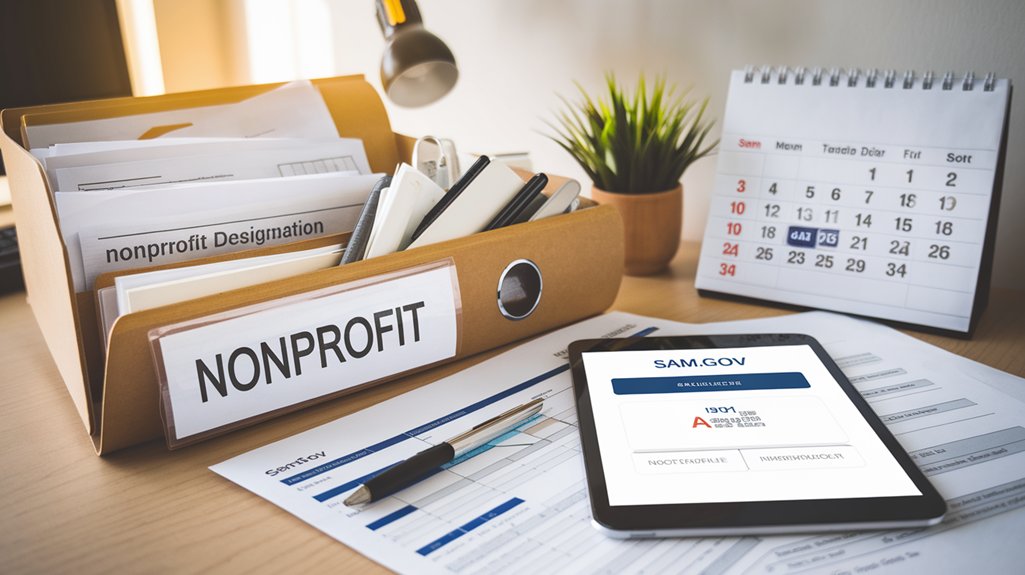501(c)(3) organizations must complete several steps for SAM registration: obtain a Unique Entity ID (UEI), gather essential documentation (EIN, banking details, NAICS code), create a SAM.gov account, and complete all required sections. The process typically takes 2-4 weeks and requires annual renewal to maintain eligibility for federal funding. Organizations must guarantee all information matches IRS records and implement proper financial tracking systems. The following guide provides thorough instructions for successful registration.
Essential Eligibility Requirements for Non-Profit SAM Registration

Every 501(c)(3) organization seeking federal grants or contracts must meet several fundamental eligibility requirements before completing SAM registration. Organizations must possess a valid IRS determination letter confirming their tax-exempt status, which opens access to diverse funding sources.
A Unique Entity ID (UEI) number is required, serving as the organization’s identifier in the federal system. Non-profits must maintain active registration in SAM.gov, updating information regularly to avoid compliance challenges. Accurate and up-to-date information must be provided and maintained throughout the entire registration process. Federal grant opportunities become accessible once registration is properly completed.
Additionally, organizations must implement proper financial reporting systems to track and document all transactions.
The IRS strictly prohibits earnings from benefiting private shareholders or individuals. This restriction guarantees that organizational resources remain dedicated to charitable purposes, maintaining the integrity essential for non-profit operations in the federal funding ecosystem.
Step-by-Step SAM.gov Registration Process for 501(c)(3) Organizations

While maneuvering through federal systems can seem intimidating, the SAM.gov registration process follows a structured pathway designed for non-profit organizations seeking access to government funding opportunities.
The registration timeline typically spans 2-4 weeks, depending on validation complexities. Maintaining active registration status is essential for accessing federal grants and contracts.
Begin by creating a SAM.gov account and obtaining your Unique Entity ID (UEI). Next, gather essential documentation including your EIN, banking information, and NAICS code.
Proceed to the entity classification section, where you’ll designate your organization as a 501(c)(3) non-profit. The NAICS codes you select are crucial as they determine size standards for small business qualification in different industries.
Complete the Core Data section with your organization’s profile details, ensuring all information matches IRS records.
After submitting your registration, monitor your status through the SAM portal while awaiting approval.
Remember that annual recertification is required to maintain active status.
Required Documentation and Post-Registration Maintenance

Successfully registering in SAM.gov represents only the first phase for 501(c)(3) organizations seeking federal funding opportunities. Proper preparation with a thorough documentation checklist greatly streamlines the registration process. Organizations must gather specific items before beginning the application. Organizations should first obtain their DUNS number before initiating the SAM registration process.
Thorough preparation is key to navigating SAM.gov registration and unlocking federal funding for nonprofits.
Essential documentation includes:
- Legal structure information (corporation, trust, etc.)
- 501(c)(3) certification documentation
- Taxpayer Identification Number (TIN)
- Complete business information including physical address
After registration, maintaining an active SAM status requires consistent attention. The registration importance cannot be overstated, as lapsed status immediately impacts eligibility for federal grants and contracts.
Organizations must renew annually, update core business information when changes occur, maintain their CAGE code, and regularly monitor for potential exclusions that could affect funding eligibility.
Frequently Asked Questions
How Long Does the SAM Registration Process Typically Take?
The SAM registration timeline typically spans 7-10 business days for standard processing, though recent system updates may extend this to 10 business days.
Complex applications requiring manual review can take up to 30 business days.
The application process duration varies based on information accuracy, organizational complexity, and submission volume.
Nonprofits can streamline registration by preparing all required documentation in advance and promptly responding to any follow-up requests for additional information.
Can International Nonprofits Register in SAM?
Yes, international nonprofits can register in SAM.
The international eligibility requirements include obtaining a DUNS number from Dun & Bradstreet and providing a physical address.
Nonprofit requirements for non-U.S. organizations include submitting proof of legal status and appointing an Entity Administrator.
While international entities don’t need a U.S. Tax Identification Number unless they pay U.S. taxes, they must follow the same step-by-step registration process and maintain compliance with U.S. regulations after registration.
Are There Registration Fees for 501(C)(3) Organizations?
Registration costs for 501(c)(3) organizations include both initial and ongoing fees.
Initial application fees to the IRS range from $275 for Form 1023-EZ to $600 for the standard Form 1023.
Organizations must also budget for state-level registration expenses, which vary by location but typically include incorporation fees ($50-$500), business licenses, and charitable solicitation registrations ($0-$400 per state).
Additional costs may include legal assistance, annual report filings, and compliance-related expenses.
What Happens if My SAM Registration Expires?
When a SAM registration expires, organizations face several serious registration consequences.
They become ineligible for federal contracts, grants, and assistance programs. Payment processing for existing contracts may halt immediately, disrupting operations and vendor relationships.
The renewal process requires careful attention, as it can take several weeks to complete.
Organizations should renew at least 30 days before expiration to avoid business disruptions and maintain continuous eligibility for federal opportunities.
Can Multiple Users Access Our Organization’s SAM Account?
Yes, multiple users can access an organization’s SAM account through proper account management practices. The system is designed to support multiple individuals with different roles and permissions within the same entity.
Each person should have their own unique SAM account with specific assigned responsibilities rather than sharing login credentials, which maintains security and accountability.
Administrators can manage these user accounts, assigning appropriate roles and permissions based on each user’s organizational duties.